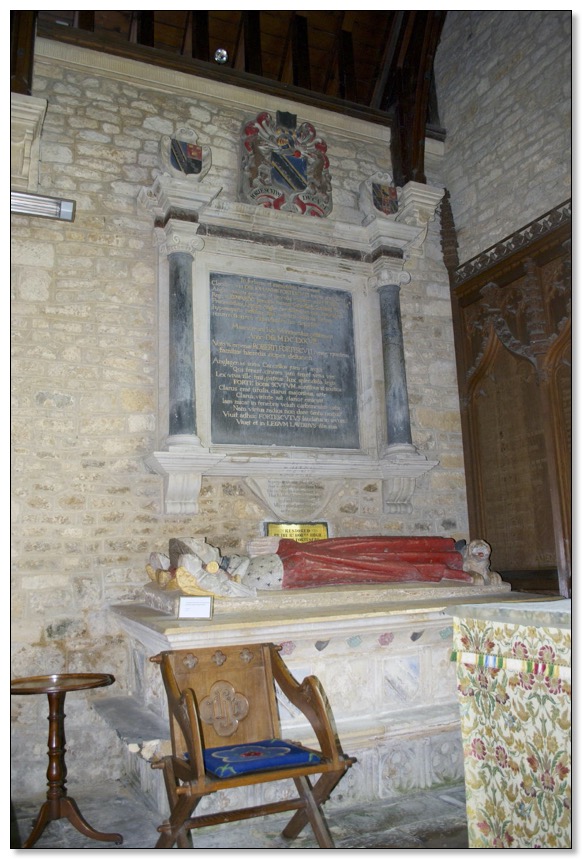Drawing of monument in Ebrington Church, Gloucestershire, of Sir John Fortescue (c.1394-1479)
Drawing of monument in Ebrington Church, Gloucestershire, of Sir John Fortescue (c.1394-1479)
Chief Justice of the King's Bench
Wikimedia Commons

Drawing of monument in Ebrington Church, Gloucestershire, of Sir John Fortescue (c.1394-1479), Chief Justice of the King's Bench. See colour photos[1]. Following description from Clermont, Lord (d.1887), History of the Family of Fortescue in all its Branches, London, 1880, pp.91-94[2]
"He was buried in the parish church, near the communion table on the north side, where his tomb still remains. The following is copied from notes taken by the author on the spot on the 8th of August, 1863. The church is not in itfelf remarkable, nor, except where a good Norman arch remains, near the tower, inside, can it be as old as the Chancellor's time. His monument is against the north wall inside the communion rails. It consists, first, of a large mural tablet, put up in 1677 by Colonel Robert Fortescue, the then owner of the family property, surmounted by the Fortescue arms, bearing the following inscription:
In Felicem et immortalem memoriam Clarissimi Viri Domini JOHANNIS FORTESCUTI Militis Granda;vi Anglic Judicis Primarii Et processu temporis sub I lenr. VI. Rege et Edwardo Principe summi Cancellarii Regis Consiliarii prudentissimi, Legum Angliae peritissimi Necnon earundem Hyperaspistae Fortissimi Qui Corporis Exuvias Laetam Refurrectionem expectantes Flic deposuit. Marmoreum hue monumentum Positum est AD MDCLXXVII Voto et Expends Roberti Fortefcuti Armigeri eiusdem Familias Haeredis nuper defuncti Angligenas intra Cancellos Juris et iEqui Qui tenuit, Cineres jam tenet Urna Viri. Lex viva ille fuit Patriae, Lux fplendida Legis,
Forte bonis fcutum, fontibus et scutica. Clarus erat titulis, clarus Majoribus, Arte Clarus, virtute aft clarior emicuit. Jam micat in tenebris, veluti Carbunculus Orbi, Nam Virtus radios non dare tanta nequit. Vivit adhuc Fortefcutus laudatus in iEvum ; Vivit et in Legum laudibus ille fuis.
In Englifh thus (trans: Biographia Britannica):
To The happy and immortal memory Of that moft famous man Sir John Fortescue, An ancient Knight, Chief Juftice of England, And in procefs of time, under Henry VI. And Prince Edward, High Chancellor. Of the King, the mod prudent councellor, In the laws of England profoundly learned, And of thefe laws alfo A Champion Invincible; Whofe earthly remains, in expectation of A joyful Refurrection, Are here depofited; This marble monument Is erected MDCLXXVII. By the direction and at the expense of Robert Fortefcue, Efq. The direct heir of this family, lately deceafed.
Below the tablet on a small slab are these words :
— To perpetuate the memory of that learned and excellent man, Chancellor Fortescue, this monument was repaired by his descendant, Matthew Lord Fortescue, in the year 1765."
And on a brass plate, still lower on the wall:
Restored by the Right Honble. Hugh 3rd Earl Fortescue, AD 1861".
Below this is the tomb itself, surmounted by a full-length figure of the Chancellor in red robes and cap, very brilliant in their new paint, lying on his back, with the hands joined as in prayer. On the three sides of the tomb the family arms are repeated several times on shields, also coloured newly. The tomb and figure are suppofed to have been erected soon after the Chancellor's death. The print annexed, from Mr. Maunde's drawing, is a perfectly correct representation of the whole. The antiquary Thomas Hearne in his unpublished diary corrects a mistake made by some authors as to the age of the tomb. He writes, November 29th, 1733:
"Sir Robert Atkyns, in his description of Gloucestershire, hath made a gross mistake (in which he hath been followed by Bishop Gibson, the author of the 'Magna Britannia', &c. &c.) in asserting that my Lord Chancellor Fortescue's monument, with his effigies, in Ebburton Church, was set up by his heir in 1677. For tho' it be true that in the year 1677 a monument with an inscription was fixed in the wall on the north side the chancel, yet that with his effigies (which is a raisfed monument of free-stone, finely painted in colours, standing on the north fide the chancel, within the communion rails) was erected, as any eye may witness by the form of the workmanship, immediately after his death."
The writer of Fortescue's Life, in the "Biographia Britannica", in like manner says that the old tomb and figure were, judging by their appearance of antiquity, and by the style of their workmanship, probably executed foon after his interment.
Source : http://fortescue.org/gallery/main.php?g2_itemId=424
Author : "Mr. Maunde"


Source : http://fortescue.org/site/manor-houses/ebrington-manor-gloucestershire/![]()


